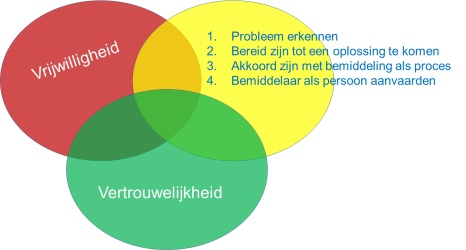Conflict is part of life. Every human being is equipped with a number of “tools” to solve their own problems. But sooner or later, people get “stuck” at certain triggers or recurring patterns in communication. When people choose to go to Court, often this leads to irreparable rupture in relationships or communications with two camps of winner and loser.
Practical advantages to mediation are that it is faster and most of the time more cost-effective than litigation.
A mediation takes place under the following conditions:

Succesfull mediation requires following conditions:
- Confidentiality
- Voluntary
- Recognition of the problem and the will to contribute to the solution
An agreement drawn up by an accredited mediator is legally valid. More so, the agreement can be submitted by either party to the court for homologation purposes. This provides the agreement the same status and thus enforceability as a “judgment” pronounced by a judge.
Confidentiality initially applies only to the mediation process. However, parties may agree that the agreement itself also remains “confidential. This confidentiality also does not prevent homologation.

Mediation is an alternative way of resolving conflicts.
Quite often it’s easier to talk about a conflict with a neutral and independent person; a third party that assists in resolving or redirecting the communication.
This is the role the mediator assumes.
The goal of mediation is to find a solution that is feasible and acceptable to all parties. People sit down with a mediator to make decisions in an efficient and sustainable way necessary to move forward with their lives. People gain an understanding of each other’s points of view and gain insight into the other’s emotional process. In this way, constructive solutions/decisions emerge.
Sexual transgressive behavior is defined as any behavior with sexual connotation that has the purpose or effect of violating a person’s dignity or creating an intimidating, hostile, offensive, humiliating or offensive environment. These behaviors can be verbal, nonverbal or physical.
Sexual transgressive behavior can also be reflected in the environment. Consider, for example, a classroom where there are posters of naked women and where co-workers are constantly telling lewd jokes among themselves.
Sexual statements or jokes, or accessing porn sites at work also fall under the definition of sexually transgressive behavior.
Why do victims often not realize they are victims?
Situations of sexually transgressive behavior are often characterized by a certain ambiguity, so that the victim is is not sure Whether he/she is a victim. Sexual transgressive behavior does not only manifest itself in touching, as is sometimes thought. A person can be the victim of unwanted behavior without being specially targeted, by being in a environment with strong sexual connotations to be located.
Moreover, a victim of unwanted behavior can seemingly participate and thus contribute to this atmosphere. Laughter or sexual statements can be a sign of embarrassment, of wanting to belong to the group or a defense mechanism.
How to respond when confronted with inappropriate behavior?
Victims are often paralyzed and then do not see what is going on. Hence the importance of preventive information so that employees are better armed when problems arise:
- Consider the feeling of discomfort you are experiencing as a signal that cannot be ignored;
- say clearly that a statement or certain behavior bothers you, and ask that it stop;
- dare to set limits: this is different for everyone and not everyone has the same sense of humor;
- talk about it with those around you and, if necessary, with your company’s occupational physician, prevention advisor or confidential advisor;
- note the facts and provide chronological traces (e-mail, text message);
- Don’t shut yourself up inside yourself;
- Be guided by a
accredited mediator.
What are the benefits of counseling sexually transgressive behavior through mediation?
Mediation takes place under clear conditions.
These are “confidentiality,” “voluntariness” and “the recognition by the parties that there is a problem to which they – under the guidance of a professional (accredited mediator) – wish to give a solution.
In particular, confidentiality is often a primary reason for mediation.
The agreement – at the request of the parties – can be kept confidential and, if desired, can be homologated by the court giving it the same terms of execution as a judgment.
Bullying at work consists of various behaviors that have the purpose or effect (depending on whether intent is involved or not) that:
- the personality, dignity or physical or psychological integrity of a person is impaired
- this person’s job is endangered
- A threatening, hostile, offensive, humiliating or offensive environment is created
To be considered harassment, the conduct must be unlawful and take place over a period of time. Violence at work manifests itself mainly through behavior, words, threats, actions, gestures or one-sided writings.
What are the benefits of managing bullying behavior through mediation?
Mediation takes place under clear conditions.
These are “confidentiality,” “voluntariness” and “the recognition by the parties that there is a problem to which they – under the guidance of a professional (accredited mediator) – wish to give a solution.
In particular, confidentiality is often a primary reason for mediation.
The agreement – at the request of the parties – can be kept confidential and, if desired, can be homologated by the court giving it the same terms of execution as a judgment.
A labor dispute is a conflict situation between an employee and employer. Labor conflict occurs when oppositions persist for a long time and are not properly resolved, people become frustrated and feel personally hampered.
Labor disputes stem from a variety of events. From a simple disagreement that gets out of hand to clashing beliefs about the right way to work within the company. A new approach, the employer’s requirement that the employee work overtime or relocate the work location, one that requires much more travel time. You were promised a bonus, promotion or salary increase that is not coming.
Common conflicts occur with:
- evaluation and performance interviews
- promotional opportunities
- soured working relationship between employee and supervisor
- soured working relationships between employees
The social mediator’s assignments include:
- the prevention of social disputes and monitoring their outbreak, progress and termination;
- fulfilling all social mediation assignments;
- supporting the various negotiation and consultation bodies established pursuant to the law of December 19, 1974 regulating relations between the government and the unions of its staff;
A social mediator may be appointed in all situations of social unrest.
This form of mediation is very useful for a social conflict is present. Preventive mediation and bringing parties together is an effective form of minimizing or avoiding social unrest.
In this, the social mediator takes the role of guiding conflicts arising from organizational change.
Organizational changes may include:
- Internal change mostly impacting existing functions and functioning of the organization
- Acquisitions where multiple approaches and cultures involve conflicts
- Merging multiple organizations (or departments) where conflicts arise
This form of social mediation is also ideally suited to identify conflicts as early as possible in a preventive manner and discuss necessary mitigation actions with the parties
With the help of a mediator, victims and offenders can start the conversation about facts and consequences of a crime. In this way, questions can be answered, agreements can be made and victims and perpetrators can give the event a place.
If you choose mediation, you as the victim can take an active role, taking the conflict back into your own hands. You and the offender can both bring your story, express any expectations and look for a way to deal with the fallout.
How does victim-offender mediation work?
Victim-offender mediation aims to establish a dialogue between you and the offender (or someone close to you) so that you can find answers and solutions on your own. A neutral mediator tries to establish communication.
When you and the offender want to mediate, the conduct of the mediation is in the hands of the mediator and the parties involved. Usually the mediator shuttles several times between victim and offender to convey messages. Sometimes mediation leads to a direct meeting between victim and offender. Only if both of you agree can a meeting take place.
Mediation is always tailored to you and the offender. Each mediation is different, with its own emphases, depending on each person’s needs.
Mediation is available for all crimes, at any time during the proceedings. So even before the case goes to court, during the hearing of the case and after the judge has rendered a verdict.